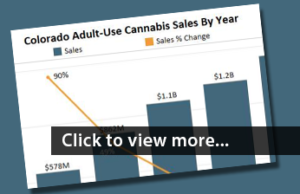The Maturity of the Market

Colorado cannabis users have spent about $1.42 billion on cannabis through August, positioning the industry to exceed $2 billion in 2020 sales – four years earlier than industry experts’ predictions.
These numbers come as the Marijuana Enforcement Division released an in-depth report on the Colorado cannabis market, which was prepared by MPG Consulting (formerly the Marijuana Policy Group) and Colorado Boulder’s Leeds School of Business. The key themes include:
- The regulated market is nearing maturity as evidenced by price trends, supply patterns and consolidation.
- A larger and more compliant market has emerged and includes accurate reporting, better internal controls, better use of the inventory tracking system by state and industry, and an effective regulatory and enforcement system.
- Most all regulated marijuana products have continued to decline due to improvements in production efficiencies and competition.
- Adult use marijuana sales are still increasing, medical sales, not so much.
- Shifting demand to Concentrates continues.
- Average potency continues a steady increase while price per dose is decreasing.
- Consumption is increasing among Colorado adults.




 Listen:
Listen:  Read:
Read: In Colorado, a
In Colorado, a 




 Cannabis monthly sales reached the highest monthly total ever in August, according to the Colorado Department of Revenue. In the first eight months of 2019, Colorado has reported over $1.15 billion in dispensary sales – indicating that the industry is on track to eclipse last year’s overall sales of $1.55 billion.
Cannabis monthly sales reached the highest monthly total ever in August, according to the Colorado Department of Revenue. In the first eight months of 2019, Colorado has reported over $1.15 billion in dispensary sales – indicating that the industry is on track to eclipse last year’s overall sales of $1.55 billion.






 As we’ve been saying for quite some time, seniors are
As we’ve been saying for quite some time, seniors are 
